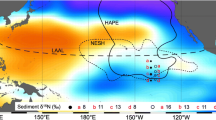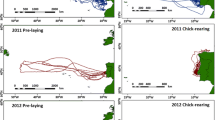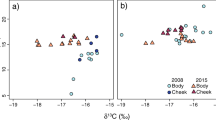Abstract
Marine animals forage in areas that aggregate prey to maximize their energy intake. However, these foraging ‘hot spots’ experience environmental variability, which can substantially alter prey availability. To survive and reproduce animals need to modify their foraging in response to these prey shifts. By monitoring their inter-annual foraging behaviours, we can understand which environmental variables affect their foraging efficiency, and can assess how they respond to environmental variability. Here, we monitored the foraging behaviour and isotopic niche of little penguins (Eudyptula minor), over 3 years (2008, 2011, and 2012) of climatic and prey variability within Port Phillip Bay, Australia. During drought (2008), penguins foraged in close proximity to the Yarra River outlet on a predominantly anchovy-based diet. In periods of heavy rainfall, when water depth in the largest tributary into the bay (Yarra River) was high, the total distance travelled, maximum distance travelled, distance to core-range, and size of core- and home-ranges of penguins increased significantly. This larger foraging range was associated with broad dietary diversity and high reproductive success. These results suggest the increased foraging range and dietary diversity of penguins were a means to maximize resource acquisition rather than a strategy to overcome local depletions in prey. Our results demonstrate the significance of the Yarra River in structuring predator–prey interactions in this enclosed bay, as well as the flexible foraging strategies of penguins in response to environmental variability. This plasticity is central to the survival of this small-ranging, resident seabird species.





Similar content being viewed by others
References
Arnould JPY, Dann P, Cullen JM (2004) Determining the sex of Little Penguins (Eudyptula minor) in northern Bass Strait using morphometric measurements. Emu 104:261–265. doi:10.1071/MU04035
Bakun A (2014) Active opportunist species as potential diagnostic markers for comparative tracking of complex marine ecosystem responses to global trends. ICES J Mar Sci. doi.:10.1093/icesjms/fst242
Ballance LT, Pitman RL, Fiedler PC (2006) Oceanographic influences on seabirds and cetaceans of the eastern tropical Pacific: a review. Prog Oceanogr 69:360–390. doi:10.1016/j.pocean.2006.1003.1013
Ballard G, Dugger K, Nur N, Ainley D (2010) Foraging strategies of Adélie penguins: adjusting body condition to cope with environmental variability. Mar Ecol Prog Ser 405:287–302. doi:10.3354/meps08514
Barrett RT, Erikstad KE (2013) Environmental variability and fledging body mass of common guillemot Uria aalge chicks. Mar Biol 160:1239–1248. doi:10.1007/s00227-00013-02175-y
Bearhop S, Teece MA, Waldron S, Furness RW (2000) Influence of lipid and uric acid on δ13C and δ15N values of avian blood: implications for trophic studies. Auk 117:504–507. doi:10.1642/0004-8038(2000)1117[0504:iolaua]1642.1640.co;1642
Bearhop S, Phillips R, McGill R, Cherel Y, Dawson D, Croxall J (2006) Stable isotopes indicate sex-specific and long-term individual foraging specialisation in diving seabirds. Mar Ecol Prog Ser 311:157–164. doi:10.3354/meps311157
Brooke M (2004) The food consumption of the world’s seabirds. Proc R Soc Lond B 271:S246–S248. doi:10.1098/rsbl.2003.0153
Bugoni L, McGill RAR, Furness RW (2008) Effects of preservation methods on stable isotope signatures in bird tissues. Rapid Commun Mass Spectrom 22:2457–2462. doi:10.1002/rcm.3633
Burrows MT et al (2014) Geographical limits to species-range shifts are suggested by climate velocity. Nature 507:492–495. doi:10.1038/nature12976
Calenge C (2006) The package adehabitat for the R software: a tool for the analysis of space and habitat use by animals. Ecol Model 197:516–519. doi:10.1016/j.ecolmodel.2006.1003.1017
Ceia F et al (2014) Annual and seasonal consistency in the feeding ecology of an opportunistic species, the yellow-legged gull Larus michahellis. Mar Ecol Prog Ser 497:273–284. doi:10.3354/meps10586
Certain G, Bellier E, Planque B, Bretagnolle V (2007) Characterising the temporal variability of the spatial distribution of animals: an application to seabirds at sea. Ecography 30:695–708. doi:10.1111/j.2007.0906-7590.05197.x
Chiaradia A, Kerry K (1999) Daily nest attendance and breeding performance in the little penguin Eudyptula minor at Phillip Island, Australia. Mar Ornithol 27:13–20
Chiaradia A, Nisbet ICT (2006) Plasticity in parental provisioning and chick growth in little penguins Eudyptula minor in years of high and low breeding success. Ardea 94:257–270
Chiaradia A, Costalunga A, Kerry K (2003) The diet of little penguins (Eudyptula minor) at Phillip Island, Victoria, in the absence of a major prey—Pilchard (Sardinops sagax). Emu 103:43–48. doi:10.1071/MU02020
Chiaradia A, Forero MG, Hobson KA, Cullen JM (2010) Changes in diet and trophic position of a top predator 10 years after a mass mortality of a key prey. ICES J Mar Sci 67:1710–1720. doi:10.1093/icesjms/fsq1067
Chiaradia A et al (2012) Diet segregation between two colonies of little penguins Eudyptula minor in southeast Australia. Austral Ecol 37:610–619. doi:10.1111/j.1442-9993.2011.02323.x
Collins M, Cullen JM, Dann P (1999) Seasonal and annual foraging movements of little penguins from Phillip Island, Victoria. Wildl Res 26:705–721. doi:10.1071/WR98003
Dann P (1988) An experimental manipulation of clutch size in the little penguin Eudyptula minor. Emu 88:101–103
Edwards M, Richardson AJ (2004) Impact of climate change on marine pelagic phenology and trophic mismatch. Nature 430:881–884. doi:10.1038/nature02808
Elliott KH, Woo KJ, Gaston AJ, Benvenuti S, Dall’Antonia L, Davoren GK (2009) Central-place foraging in an arctic seabird provides evidence for Storer-Ashmole’s Halo. Auk 126:613–625. doi:10.1525/auk.2009.08245
Environmental Protection Agency Victoria (2012) Baywide water quality monitoring program. Milestone report number 9 Environment Protection Agency, Victoria. pp 1–107
Fry B (2006) Stable isotope ecology. Springer, New York
Gales R, Green B (1990) The annual energetics cycle of little penguins (Eudyptula Minor). Ecology 71:2297–2312
Gaston AJ, Ydenberg RC, Smith GJ (2007) Ashmole’s halo and population regulation in seabirds. Mar Ornithol 35:119–126
Gillson J, Suthers I, Scandol J (2012) Effects of flood and drought events on multi-species, multi-method estuarine and coastal fisheries in eastern Australia. Fish Manag Ecol 19:54–68. doi:10.1111/j.1365-2400.2011.00816.x
Grimes CB, Finucane JH (1991) Spatial distribution and abundance of larval and juvenile fish, chlorophyll and macrozooplankton around the Mississippi River discharge plume, and the role of the plume in fish recruitment. Mar Ecol Prog Ser 75:109–119
Grimes C, Kingsford M (1996) How do riverine plumes of different sizes influence fish larvae: do they enhance recruitment? Mar Freshw Res 47:191–208. doi:10.1071/MF9960191
Harley C et al (2006) The impacts of climate change in coastal marine systems. Ecol Lett 9:228–241. doi:10.1111/j.1461-0248.2005.00871.x
Hirst AJ, White CA, Green C, Werner GF, Heislers S, Spooner D (2011) Baywide anchovy study sub-program. Milestone report No. 4 Technical report No. 150. Department of Primary Industries, Queenscliff,Victoria, Australia
Hobson KA, Clark R (1993) Turnover of 13 C in cellular and plasma fractions of blood: implications for nondestructive sampling in avian dietary studies. Auk 11:638–641
Hobson KA, Piatt JF, Pitocchelli J (1994) Using stable isotopes to determine seabird trophic relationships. J Anim Ecol 63:786–798
Hobson KA, Gloutney ML, Gibbs HL (1997) Preservation of blood and tissue samples for stable-carbon and stable-nitrogen isotope analysis. Can J Zool 75:1720–1723
Hothorn T, Hornik K, Zeileis A (2006) Unbiased recursive partitioning: a conditional inference framework. J Comput Graph Stat 15:651–674. doi:10.1198/106186006x106133933
Hothorn T, Hornik K, Zeileis A (2011) party: A laboratory for recursive part (y) itioning. http://cran.r-project.org/package=party
Jackson AL, Inger R, Parnell AC, Bearhop S (2011) Comparing isotopic niche widths among and within communities: SIBER—Stable Isotope Bayesian Ellipses in R. J Anim Ecol 80:595–602. doi:10.1111/j.1365-2656.2011.01806.x
Jaeger A, Connan M, Richard P, Cherel Y (2010) Use of stable isotopes to quantify seasonal changes of trophic niche and levels of population and individual specialisation in seabirds. Mar Ecol Prog Ser 401:269–277. doi:10.3354/meps08380
Jodice P et al (2006) Increased energy expenditure by a seabird in response to higher food abundance. Mar Ecol Prog Ser 306:283–293. doi:10.3354/meps306283
Johnstone CP, Lill A, Reina RD (2014) Habitat loss, fragmentation and degradation effects on small mammals: analysis with conditional inference tree statistical modelling. Biol Conserv 176:80–98. doi:10.1016/j.biocon.2014.1004.1025
Kingsford MJ, Suthers IM (1994) Dynamic estuarine plumes and fronts: importance to small fish and plankton in coastal waters of NSW, Australia. Cont Shelf Res 14:655–672. doi:10.1016/0278-4343(1094)90111-90112
Kotzerka J, Hatch SA, Garthe S (2011) Evidence for foraging-site fidelity and individual foraging behaviour of Pelagic Cormorants rearing chicks in the Gulf of Alaska. Condor 113:80–88. doi:10.1525/cond.2011.090158
Kowalczyk ND, Chiaradia A, Preston TJ, Reina RD (2013) Linking dietary shifts and reproductive failure in seabirds: a stable isotope approach. Funct Ecol 28:755–765. doi:10.1111/1365-2435.12216
Kowalczyk ND, Chiaradia A, Preston TJ, Reina RD (2015) Fine-scale dietary changes between the breeding and non-breeding diet of a resident seabird. R Soc Open Sci. doi:10.1098/rsos.140291
Kudela RM et al (2010) Multiple trophic levels fueled by recirculation in the Columbia River plume. Geophys Res Lett 37:L18607. doi:10.11029/12010gl044342
Le Fèvre J (1987) Aspects of the biology of frontal systems. In: Blaxter JHS, Southward AJ (eds) Advances in marine biology, vol 23. Academic, New York, pp 163–299
Lee R, Black K, Bosserel C, Greer D (2012) Present and future prolonged drought impacts on a large temperate embayment: Port Phillip Bay, Australia. Ocean Dyn 62:907–922. doi:10.1007/s10236-10012-10538-10234
Levins R (1968) Evolution in changing environments. Princeton University, Princeton
Litz MNC, Emmett RL, Bentley PJ, Claiborne AM, Barceló C (2014) Biotic and abiotic factors influencing forage fish and pelagic nekton community in the Columbia River plume (USA) throughout the upwelling season 1999–2009. ICES J Mar Sci 71:5–18. doi:10.1093/icesjms/fst1082
MacArthur RH, Pianka ER (1966) On optimal use of a patchy environment. Am Nat 100:603–609
Martínez del Rio C, Sabat P, Anderson-Sprecher R, Gonzalez S (2009) Dietary and isotopic specialization: the isotopic niche of three Cinclodes ovenbirds. Oecologia 161:149–159. doi:10.1007/s00442-00009-01357-00442
Mattern T, Ellenberg U, Houston D, Davis L (2007) Consistent foraging routes and benthic foraging behaviour in yellow-eyed penguins. Mar Ecol Prog Ser 343:295–306. doi:10.3354/meps06954
Mattern T et al (2013) Straight line foraging in yellow-eyed penguins: new insights into cascading fisheries effects and orientation capabilities of marine predators. PLoS ONE 8:e84381. doi:10.81371/journal.pone.0084381
Morales JM et al (2010) Building the bridge between animal movement and population dynamics. Philos Trans R Soc Lond B 365:2289–2301. doi:10.1098/rstb.2010.0082
Murray BG (2000) Measuring annual reproductive success in birds. The Condor 102:470–473. doi:10.1650/0010-5422(2000)1102[0470:marsib]1652.1650.co;1652
Parnell A, Inger R, Bearhop S, Jackson A (2008) SIAR: stable isotope analysis in R. cran. r-project. org/web/packages/siar/
Parry G, Stokie T (2008) Baywide anchovy study sub-program: Milestone report No.1 Technical Report No. 23. Department of Primary Industries, Australia, pp 1–28
Pelletier L, Chiaradia A, Kato A, Ropert-Coudert Y (2014) Fine-scale spatial age segregation in the limited foraging area of an inshore seabird species, the little penguin. Oecologia 176:399–408. doi:10.1007/s00442-00014-03018-00443
Pettex E et al (2012) Multi-scale foraging variability in Northern gannet (Morus bassanus) fuels potential foraging plasticity. Mar Biol 159:2743–2756. doi:10.1007/s00227-00012-02035-00221
Pinaud D, Cherel Y, Weimerskirch H (2005) Effect of environmental variability on habitat selection, diet, provisioning behaviour and chick growth in yellow-nosed albatrosses. Mar Ecol Prog Ser 298:295–304. doi:10.3354/meps298295
Preston T (2010) Relationships between foraging behaviour, diet and reproductive success at an urban colony of little penguins (Eudyptula minor), St Kilda. Australia School of Biological Sciences. Monash University
Preston T et al (2008) Foraging behaviour of little penguins Eudyptula minor in an artificially modified environment. Endanger Species Res 4:95–103. doi:10.3354/esr00069
Pyke GH, Pulliam HR, Charnov EL (1977) Optimal foraging: a selective review of theory and tests. Q Rev Biol 52:137–154
Quinn GP, Keough MJ (2002) Experimental design and data analysis for biologists. Cambridge University Press, Cambridge
R Development Core Team (2009) R: a language and environment for statistical computing, Vienna, Austria. http://www.R-project.org
Richards W, Leming T, McGowan M, Lamkin J, Kelley-Fraga S (1989) Distribution of fish larvae in relation to hydrographic features of the Loop Current boundary in the Gulf of Mexico. Rapp P-V Reunions Cons Int Explor Mer 191:169–176
Rindorf A, Wanless S, Harris M (2000) Effects of changes in sandeel availability on the reproductive output of seabirds. Mar Ecol Prog Ser 202:241–252
Ropert-Coudert Y, Wilson RP, Daunt F, Kato A (2004) Patterns of energy acquisition by a central place forager: benefits of alternating short and long foraging trips. Behav Ecol 15:824–830. doi:10.1093/beheco/arh1086
Ropert-Coudert Y, Kato A, Wilson R, Cannell B (2006) Foraging strategies and prey encounter rate of free-ranging Little Penguins. Mar Biol 149:139–148. doi:10.1007/s00227-00005-00188-x
Ropert-Coudert Y, Knott N, Chiaradia A, Kato A (2007) How do different data logger sizes and attachment positions affect the diving behaviour of little penguins? Deep-sea Res II 54:415–423. doi:10.1016/j.dsr1012.2006.1011.1018
Sæther BE (2000) Weather ruins winter vacations. Science 288:1975–1976. doi:10.1126/science.1288.5473.1975
Salton M, Saraux C, Dann D, Chiaradia A (2015) Carry-over body mass effect from non-breeding to breeding in a resident seabird, the Little penguin. R Soc Open Sci 2:140–390. doi:10.1098/rsos.140390
Sidhu L, Catchpole E, Dann P (2007) Mark-recapture-recovery modeling and age-related survival in Little Penguins (Eudyptula minor). Auk 124:815–827. doi:10.1642/0004-8038(2007)1124[1815:MMAASI]1642.1640.CO;1642
Skov H, Prins E (2001) Impact of estuarine fronts on the dispersal of piscivorous birds in the German Bight. Mar Ecol Prog Ser 214:279–287. doi:10.3354/meps214279
Stephens DW, Krebs JR (1986) Foraging theory. Princeton University Press, Princeton
Suryan RM, Irons DB, Benson J (2000) Prey switching and variable foraging strategies of black-legged kittiwakes and the effect on reproductive success. Condor 102:374–384
Tremblay Y, Thiebault A, Mullers R, Pistorius P (2014) Bird-borne video-cameras show that seabird movement patterns relate to previously unrevealed proximate environment, not prey. PLoS ONE 9:e88424. doi:10.81371/journal.pone.0088424
Voice M, Harvey N, Walsh K (2006) Vulnerability to climate change of Australia’s coastal zone: analysis of gaps in methods, data and system thresholds. Report to the Australian Greenhouse Office, Australia
Weimerskirch H (2007) Are seabirds foraging for unpredictable resources? deep sea research part II. Trop Stud Oceanogr 54:211–223. doi:10.1016/j.dsr1012.2006.1011.1013
Weimerskirch H et al (2003) Foraging efficiency and adjustment of energy expenditure in a pelagic seabird provisioning its chick. J Anim Ecol 72:500–508. doi:10.1046/j.1365-2656.2002.00720.x
Weimerskirch H, Gault A, Cherel Y (2005) Prey distibution and patchiness: factors in foraging success and efficiency of wandering albatrosses. Ecology 86:2611–2622. doi:10.1890/2604-1866
Welcker J, Harding AMA, Kitaysky AS, Speakman JR, Gabrielsen GW (2009) Daily energy expenditure increases in response to low nutritional stress in an Arctic-breeding seabird with no effect on mortality. Funct Ecol 23:1081–1090. doi:10.1111/j.1365-2435.2009.01585.x
Wilson RP (1997) Long-term attachment of transmitting and recording devices to penguins and other seabirds. Wildl Soc Bull 25:101–106
Zamon JE, Phillips EM, Guy TJ (2014) Marine bird aggregations associated with the tidally-driven plume and plume fronts of the Columbia River. Deep Sea Res II 107:85–95. doi:10.1016/j.dsr1012.2013.1003.1031
Acknowledgments
Parks Victoria granted permission to work along the breakwater. We thank Holsworth Wildlife Research Trust, Penguin Foundation, and Coastcare Australia for financial support. We acknowledge Earthcare St Kilda and Phillip Island Nature Parks for their in-kind support. We thank the Environment Protection Agency and Melbourne Water for environmental data. We thank all research volunteers especially Lisa Mandeltort for their tireless efforts in the field and to Christopher Johnstone and Bronwyn Isaac who provided statistical and mapping advice, respectively. Research was conducted under scientific permits issued by the Victorian Department of Sustainability and the Environment (10003848, 10005601), and approved by the Animal Ethics Committee of Monash University (BSCI/2010/22, BSCI/2011/33).
Author information
Authors and Affiliations
Corresponding author
Additional information
Communicated by Christian Voigt.
Rights and permissions
About this article
Cite this article
Kowalczyk, N.D., Reina, R.D., Preston, T.J. et al. Environmental variability drives shifts in the foraging behaviour and reproductive success of an inshore seabird. Oecologia 178, 967–979 (2015). https://doi.org/10.1007/s00442-015-3294-6
Received:
Accepted:
Published:
Issue Date:
DOI: https://doi.org/10.1007/s00442-015-3294-6




